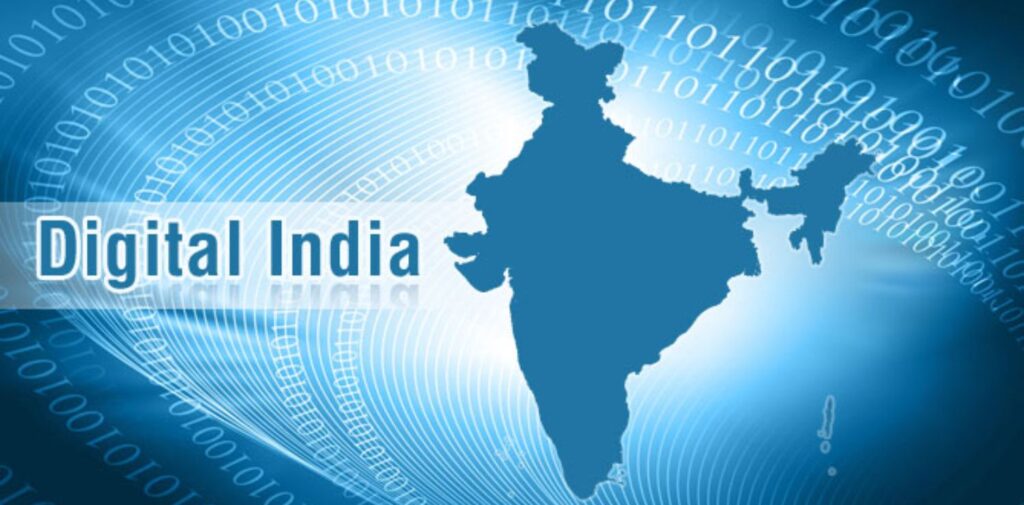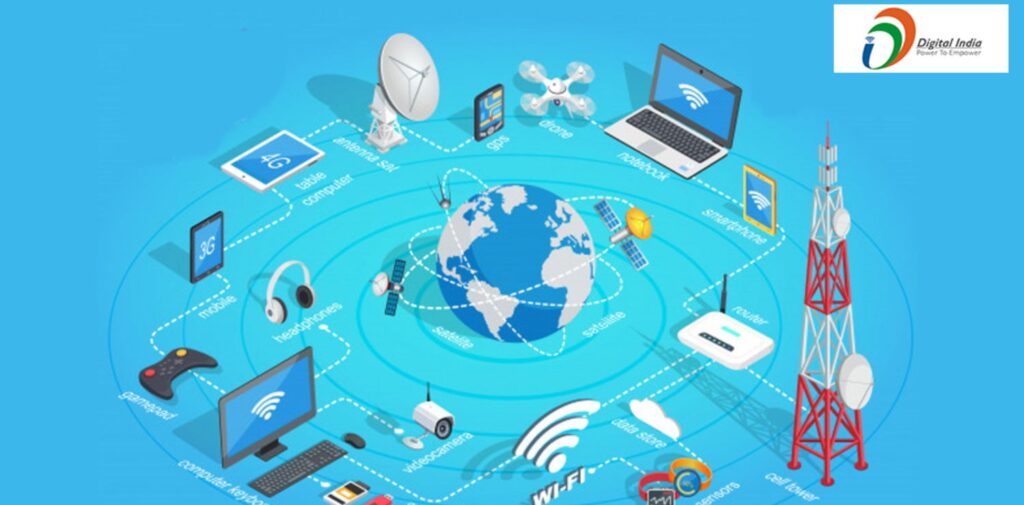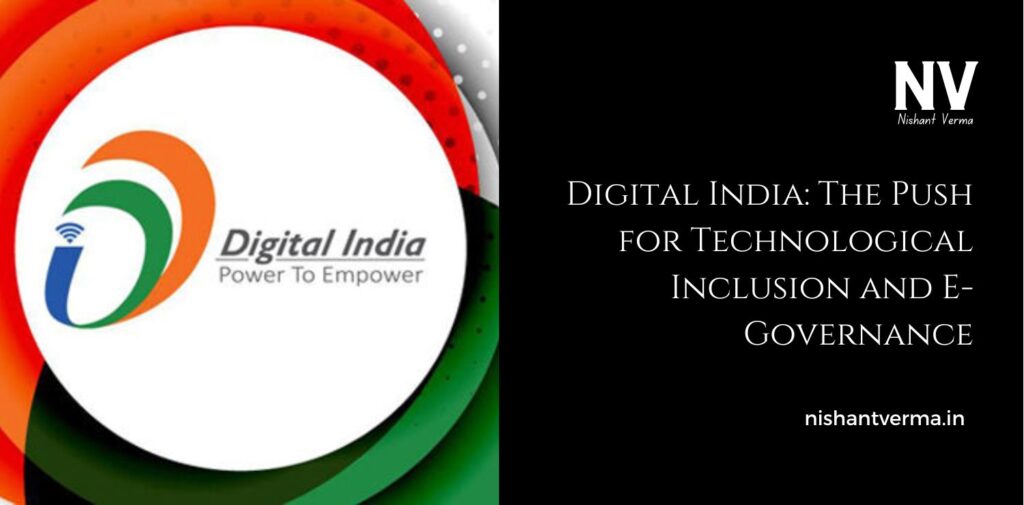In today’s world, technology is everywhere. From smartphones to computers, technology has made our lives easier, faster, and more connected. In India, the government has launched an initiative called Digital India, which is working to make the country more connected and digitally advanced. Digital India aims to use technology to bring people closer, improve government services, and make India a smarter and more efficient country. In this article, we will explore what Digital India is all about, how it works, and why it is so important for the country’s future.

What is Digital India?
Digital India is a government initiative that was launched in 2015 with the goal of transforming India into a digitally empowered society and knowledge economy. The main idea behind Digital India is to use technology to improve the way people live, work, and interact with the government. The program focuses on providing digital services to every citizen, regardless of where they live or how old they are.
The initiative is designed to help India become a leader in the digital world. It aims to make it easier for people to access government services, learn new skills, and do business online. Digital India is not just about technology; it’s about improving people’s lives and ensuring that everyone in the country can benefit from the opportunities that technology offers.
The Three Key Areas of Digital India
Digital India is built on three main pillars, or goals, that guide the program’s work:
- Digital Infrastructure as a Utility to Every Citizen
- Governance and Services on Demand
- Digital Empowerment of Citizens
Let’s explore each of these pillars in more detail.
Digital Infrastructure as a Utility to Every Citizen
One of the main goals of Digital India is to make sure that every citizen has access to the basic digital infrastructure needed to use technology. This means that the government is working to ensure that everyone has access to the internet, smartphones, computers, and other digital tools.
In many parts of India, especially in rural areas, people did not have easy access to these tools. This made it difficult for them to take advantage of digital services, like online education or government schemes. But through Digital India, the government is working to improve internet connectivity across the country, especially in remote areas. For example, the government has set up Wi-Fi hotspots in many places, allowing people to access the internet for free or at a low cost.
In addition, the government has been working to improve mobile phone networks so that more people can connect to the internet through their phones. This helps bridge the digital divide between urban and rural areas.
Governance and Services on Demand
Digital India is also focused on making government services available online, so people don’t have to visit government offices in person. This is called e-governance, and it’s one of the biggest achievements of Digital India. With e-governance, citizens can access government services, pay taxes, apply for permits, and more, all from the comfort of their own homes.
For example, citizens can now access important services like applying for passports, registering land, paying bills, and even filing taxes online. This saves people a lot of time and effort and makes government services more efficient. Instead of standing in long lines or visiting multiple offices, people can get the services they need in just a few clicks.
Additionally, Digital India ensures that government schemes and benefits reach the people who need them. With the help of digital platforms, the government can directly transfer subsidies and benefits to citizens, making sure that the right people get help at the right time.

Digital Empowerment of Citizens
The third pillar of Digital India is about empowering people with the skills and knowledge they need to use technology effectively. In today’s world, knowing how to use a computer or smartphone is essential for learning, working, and connecting with others. However, many people, especially in rural areas, have little experience with technology. To address this, the government has launched various programs to train and educate people on how to use digital tools.
Through programs like Pradhan Mantri Gramin Digital Saksharta Abhiyan (PMGDISHA), the government is providing digital literacy to people in rural and remote areas. This program teaches people how to use a computer, access the internet, and carry out online tasks such as banking or shopping.
Additionally, Digital India is also helping people learn new skills that can help them get better jobs or start their own businesses. Through online platforms and courses, people can learn everything from coding to entrepreneurship.
Digital India’s Impact on Daily Life
Digital India has had a huge impact on the lives of ordinary people. Here are some ways it is changing life in India:
- Access to Education: Education is a key focus of Digital India. With the help of technology, students can now learn from the best teachers, even if they live in remote areas. Online learning platforms and digital classrooms have made education more accessible and affordable for everyone.
- Improved Healthcare Services: Digital India has also brought improvements to the healthcare system. Through digital platforms, people can now consult doctors online, book appointments, and access their medical records. This is especially helpful for people in rural areas who may not have easy access to hospitals.
- Financial Inclusion: Digital India has made banking and financial services accessible to people who did not have a bank account before. With the rise of digital banking, people can send and receive money, pay bills, and apply for loans using their smartphones. This has helped bring many people into the financial system, which can improve their economic situation.
- Boost to Small Businesses: With Digital India, small businesses and entrepreneurs have new opportunities to grow. They can now sell their products online, reach more customers, and manage their businesses more effectively. Digital platforms like e-commerce websites and payment apps have made it easier for businesses to thrive.
- Increased Transparency and Accountability: Digital India has also made government actions more transparent. People can now track government projects, access information about how money is being spent, and even report issues like corruption online. This has helped make the government more accountable to the people.
Challenges of Digital India
Although Digital India has made huge progress, there are still some challenges to overcome. One of the main challenges is internet connectivity in remote areas. While the government has made efforts to improve access, there are still many places in India where the internet is slow or unavailable.
Another challenge is digital literacy. While many people in urban areas are comfortable using technology, some people, especially in rural areas, still lack the skills needed to use smartphones and computers. The government is working to improve digital literacy, but it is a gradual process.
Finally, there is the issue of cybersecurity. As more and more people go online, there is a risk of cybercrimes such as identity theft, hacking, and fraud. The government is working to strengthen online security, but it remains an important area of focus.

The Future of Digital India
Digital India is just getting started, and its future looks bright. In the coming years, India will continue to develop its digital infrastructure and create more opportunities for people to use technology in their everyday lives. The government is focused on making sure that no one is left behind in the digital world, and that everyone has equal access to the benefits of technology.
As India becomes more connected and digital, we will see even more changes in the way we live, work, and learn. Technology will continue to drive growth and improve the quality of life for millions of people across the country.
Conclusion
Digital India is a game-changer for the country. It is helping people access government services more easily, learn new skills, and connect with each other in new ways. Through this initiative, India is becoming a more digitally connected, efficient, and inclusive country. Although there are challenges to overcome, the future of Digital India is full of promise, and it will continue to transform the way people live and work in India for years to come.




